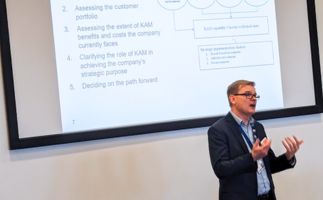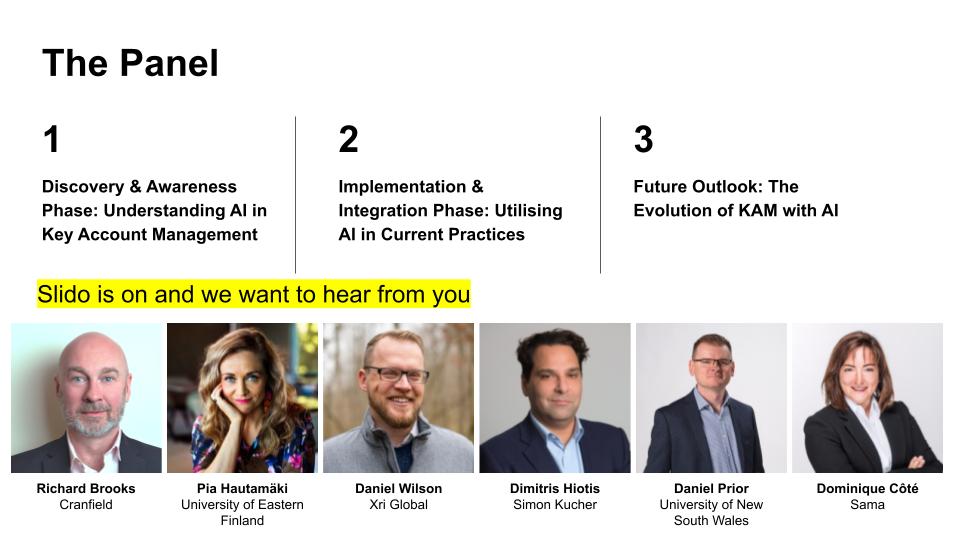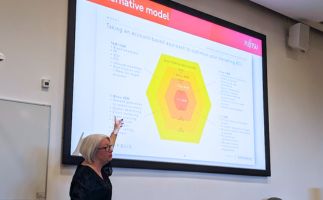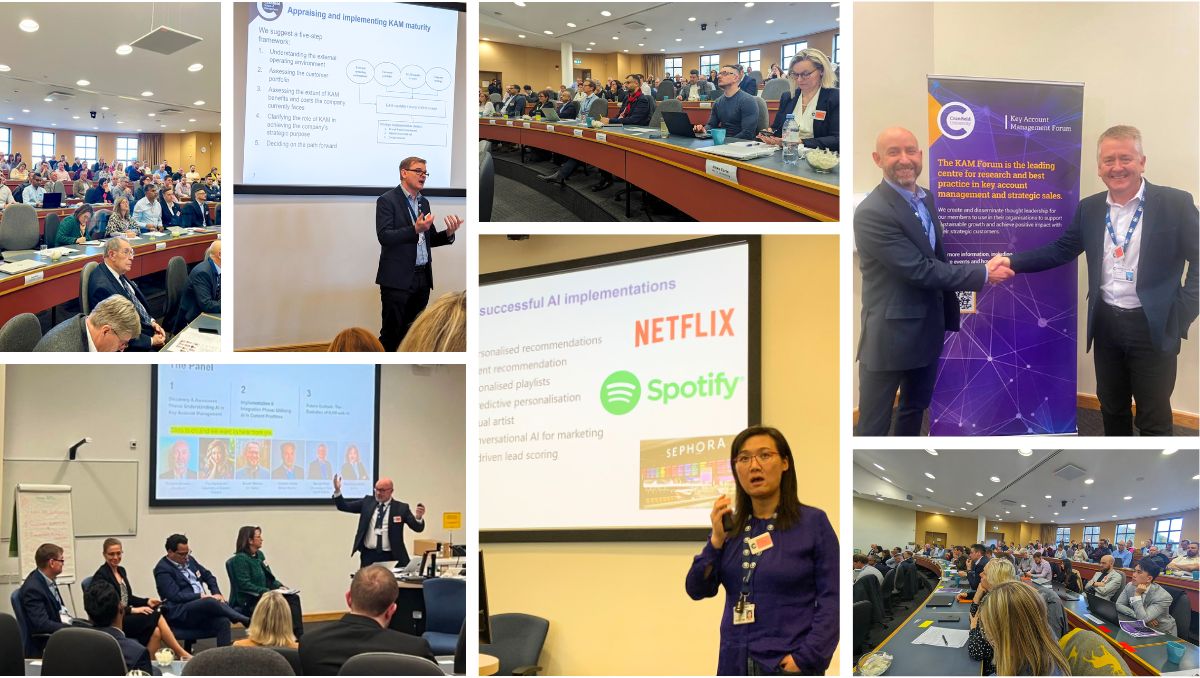Key Account Management Conference
As the chair of the Key Account Management Forum Winter Conference at Cranfield School of Management, it was my privilege to orchestrate an assembly of distinguished experts in Key Account Management (KAM), pricing strategies, and the dynamic field of Artificial Intelligence (AI). The conference, a culmination of several months of planning, was designed to serve as a nexus for disseminating groundbreaking research, actionable insights, and visionary strategies. Our exploration delved deep into the complex interplay between KAM, AI, and value-based selling, providing a panoramic view of the current landscape while casting an eye towards the future of these vital business disciplines.
The conference featured a blend of academic rigour and industry acumen, with speakers from prestigious institutions and leading companies. It became a hub for a rich exchange of ideas, offering attendees a unique opportunity to engage and network with thought leaders, peers, and practitioners in the field. In this post, I aim to distil some of the pivotal ideas shared during the event, fully aware that this is merely an introduction to the wealth of knowledge and insights that were exchanged.
Emerging Themes in Key Account Management
Professor Javier Marcos – Cranfield School of Management
Opening the official part of the conference was Professor Javier Marcos from Cranfield School of Management. He started his lecture informing that there are 230 peer-reviewed studies in Key Account Management. This number reflects the depth and breadth of the subject and underscores Cranfield’s position as a frontrunner in KAM research, ranked second globally for this discipline.

A thought-provoking aspect of this session was the exploration of the appropriate level of involvement in KAM. This question is crucial, as it addresses the balance between being sufficiently engaged with key accounts without overextending resources or overshadowing other business areas. By bringing to the forefront the significant number of studies conducted in the field, the session emphasised the necessity for businesses to stay abreast of academic research and findings. These insights can be pivotal in redefining and refining KAM strategies to ensure they are effective, efficient, and in sync with the latest methodologies and understandings in the field.
Value Creation and Pricing in Key Account Management – Theory and Practice
Dr. Peter Colman and Avi Sethi – Simon-Kucher
Dr. Peter Colman and Avi Sethi from Simon-Kucher, focused on the intricate relationship between value creation and pricing in Key Account Management. This session was particularly enlightening, bridging the gap between theoretical concepts and practical applications in the realm of pricing strategies within KAM.
A central theme of the session was the critical importance of understanding the value that a service creates before determining its price. This concept challenges the conventional approach of pricing based solely on cost or market competition. Instead, it emphasises a more nuanced understanding of the value proposition of a service. Dr. Colman and Mr. Sethi effectively used thought-provoking questions, such as reflecting on who initiates a price war, to guide the audience through the complexities of pricing decisions.

Another significant point of discussion was the concept of decommoditising services. The speakers illustrated this with a compelling analogy: no one would opt for the cheapest bulletproof vest, as its value lies not in its cost but in its performance and reliability. This analogy beautifully encapsulated the idea that even products made from commodity components can be differentiated based on their value proposition.
Further delving into the pricing strategy, the session explored the positioning of services on a price versus performance grid. This analysis aids in understanding where one’s service stands in comparison to competitors, highlighting the importance of price as a significant lever for profit. However, the speakers also noted a crucial organisational insight: mid-level personnel rarely champion price increases; such strategic decisions need to come from, and be driven by, top management (CEO/CFO).
An intriguing aspect of the session was the exploration of consumer psychology in pricing. The speakers discussed how often, consumer decisions are not entirely rational, and this irrationality can be strategically leveraged in pricing.
Dr. Colman and Mr. Sethi concluded the session by addressing the challenges businesses face in pricing strategies, especially in the context of KAM. They emphasised the need for a strategic, top-down approach in pricing decisions, underpinned by a deep understanding of the value created for the customers. This session provided valuable insights into the theory and practice of pricing in KAM and left the attendees with critical questions and strategies to ponder for their businesses.
The session concluded with an engaging and educational pricing war game, expertly facilitated by the team from Simon-Kucher. Participants were divided into ten teams, each tasked with maximising profits from the sale of imaginary fizzy drinks. Utilising Simon-Kucher’s proprietary platform, attendees had the opportunity to experiment with various pricing policies in real-time. This interactive exercise was made even more challenging and insightful as the computer introduced unexpected scenarios, testing the teams’ strategic agility. The competitive spirit of the game was very exciting, providing a practical application of pricing strategies and a revealing glimpse into human behaviour under competitive pressures.
Key Account Management Maturity Model
Professor Daniel Prior – University of New South Wales
Liang Sun – Cranfield School of Management
Professor Daniel Prior from the University of New South Wales, delved into the nuances of Key Account Management (KAM) maturity. Professor Prior introduced the audience to the “Key Account Management Maturity Model: A Preliminary Framework,” which served as the cornerstone of the session.

The presentation began with an exploration of how companies’ approaches to KAM vary significantly depending on numerous factors such as contextual elements, company goals, and customer willingness. Professor Prior emphasised that this diversity necessitates a compelling justification for KAM at the highest organisational levels, particularly due to challenges like resistance to change, lack of top management support, and unresponsive customers.
Professor Prior defined KAM maturity as “the extent to which a company’s KAM capabilities create and support strategic customer relationships that align with the company’s goals and with prevailing circumstances.” This definition set the stage for a discussion on the tangible benefits that mature KAM practices bring to an organisation. These benefits include consistent, predictable income from long-term, strategic customer relationships; innovation spurred by these partnerships; competitive insulation; customer recommendations; seamless integration of systems and processes; involvement in strategic decision-making; and reductions in both customer retention costs and the cost to serve.
Prior’s presentation included a five-step framework to appraise and implement KAM Maturity. This framework encompasses understanding the external operating environment, assessing the customer portfolio, evaluating the current benefits and costs of KAM, clarifying the role of KAM in achieving the company’s strategic objectives, and finally, deciding on the path forward.
The session was assisted with a lively debate via Slido among the attendees, providing valuable feedback and insights that contributed to Dr. Prior’s ongoing research. This interactive discussion underscored the evolving nature of KAM and its critical role in shaping business strategies.
Latest AI Innovations
Professor Ying Xie – Cranfield School of Management
Professor Ying Xie from Cranfield School of Management provided a comprehensive overview of the latest landscape in innovations in Artificial Intelligence (AI) and their impact on business, particularly in the context of Key Account Management (KAM) and customer management strategies.

Professor Xie began the session by highlighting the AI market, valued at $136.55 billion in 2022, with an expected compound annual growth rate of 37.3%. This rapid growth underscores the significance of AI in the modern business landscape and presents a lucrative opportunity for companies engaging in AI-related products and services. AI is now on the agenda of all companies.
Central to the session was the exploration of AI’s role in personalisation and customer experience, especially in the B2C sector. Professor Xie emphasised how AI-driven tools are revolutionising customer management through enhanced personalisation and efficiency. She delved into specific applications such as AI-driven personalisation techniques, recommendation systems, and dynamic pricing, illustrating how these innovations are reshaping customer interactions and expectations.
Professor Xie discussed the increasing utilisation of chatbots for both internal and external inquiries, including general information, invoices, and payment requests. The rise of chatbots in customer interaction, their role in enhancing customer service, and the concept of automated purchasing agents were key points of discussion. These AI agents, capable of finding deals and negotiating terms based on preset market parameters, exemplify AI’s transformative impact on business processes.
Professor Xie presented several successful AI implementation case studies:
- Amazon: Personalised recommendations.
- Netflix: Content recommendation algorithms.
- Spotify: Personalised playlists.
- Starbucks: Predictive personalization.
- Sephora: Virtual artist app.
- ChatGPT: Conversational AI for marketing.
- HubSpot: AI-driven lead scoring.
Applications all marketers and key account managers should have on their radar include; the automation of advertisement design and content, the significance of personalisation in customer experience, the use of immersive technologies like AR and VR, predictive analytics, chatbots and virtual assistants, and advancements in visual and voice search.
AI is reshaping the business world, large companies are leveraging AI technologies for enhanced customer engagement, operational efficiency, and strategic advantage in the realm of Key Account Management.
KAM Toolkit Update – KAM Planning Model
Mark Davies and Dr. Sue Holt – Cranfield School of Management
Cranfield and KAM legends, Mark Davies and Dr. Sue Holt focused on updating and refining the Key Account Management (KAM) Planning Model. This session began with a thought-provoking quote from George Bernard Shaw: “Beware of false knowledge; it is more dangerous than ignorance.” This set the tone for a session centred around the importance of accurate and insightful knowledge in KAM strategies.
They presented the existing Cranfield KAM Planning Framework and reminded us of the four critical questions to guide the development of an effective KAM strategy:
- “What does your customer value and need?”
- “How do you develop a clear customer strategy?”
- “How do you create a compelling customer value proposition?”
- “How do you deliver and capture the value that you promise?”
These questions highlighted the session’s core theme: KAM is about adding value both to your business and your customer’s business. The emphasis was on the outcome of a structured KAM approach rather than KAM as a product in itself.
The session underscored the shift in focus from a price-centred approach to one that is value-centred. This transition is fundamental in contemporary customer management and reflects the evolving dynamics of customer-supplier relationships.
A significant portion of the presentation was dedicated to demonstrating the limitations of traditional tools like SWOT analysis, humorously referred to as a “Stupid Waste Of Time.” Instead, Mark and Sue introduced the 9 box strategy grid, a versatile tool that serves as the “Swiss Army Knife” in the KAM toolkit. This model allows for:
- Capturing both the customer’s strategy and your own as the supplier.
- Developing broader business strategies.
- Strategising for market or industry segments.
- Personal strategic planning.
The most crucial aspect of this model, as emphasised by the presenters, is defining the purpose. They stressed the importance of carefully considering the words, numbers, and timescales used in this definition, focusing on the objectives of both the customer and the organisation.
The session concluded with a discussion around understanding and aligning with the strategic goals of customers. Questions posed included how well these goals are understood, the sources of this understanding, and the challenges faced when strategic goals lack compelling elements. This interactive and insightful session offered practical tools and strategies for effective KAM, emphasising the importance of a value-centric approach and strategic alignment in successful customer management.
AI in Key Account Management, Panel Discussion
Panellists: Richard Brooks (Cranfield), Pia Hautamäki (Adjunct Professor at University of Eastern Finland), Daniel Wilson (CEO of XRI), Dimitris Hiotis (Simon-Kucher), Dominique Côté (Sama) & Daniel Prior (University of New South Wales)

This session was a panel discussion on the integration of Artificial Intelligence (AI) in Key Account Management (KAM), featured a diverse group of experts from academia, the technology industry, and KAM practitioners. I opened the session and the stage with an statement on the rapid advancements in AI and its transformative impact on various industries, including professional sales and KAM.
The panel was structured into three main sections: Discovery, Implementation, and Future, with each section followed by a Slido poll to gauge the audience’s current situation in relation to AI in KAM. Panellists were first invited to introduce themselves, sharing their relationship with sales/KAM and their current usage of AI.
Discussion Highlights:
Discovery & Awareness Phase: Understanding AI in Key Account Management
The panel discussed how AI is currently being understood and utilised in the realm of KAM. The focus was on the role of AI in enhancing the discovery and awareness phases of sales, particularly in identifying and understanding key accounts.
Implementation & Integration Phase: Utilising AI in Current Practices
This section delved into the practical applications of AI in KAM. Panellists shared insights on how AI is being integrated into current practices, discussing tools and strategies that are reshaping the approach to KAM. Key topics included the use of generative AI for role-playing negotiation scenarios and the use of AI to handle non-revenue generating aspects of KAM, which was estimated to be around 70%.
Future Outlook: The Evolution of KAM with AI
The panel explored the potential future developments of AI in KAM, considering how AI might continue to evolve and redefine the field. The discussion covered a range of possibilities, from the ethical considerations of AI in business to the role of AI as a personal assistant and its impact on strategic decision-making.
Key Comments from the Panel
- Large Language Models (LLMs) can facilitate new ways of reasoning.
- Generative AI’s role in creating realistic negotiation scenarios.
- The potential of AI to manage the significant portion of KAM activities that do not directly generate revenue.
- Concerns about over-reliance on AI leading to a reduction in critical thinking.
- The feasibility of hosting open-source AI models for personalised use.
- The practical use of ChatGPT as a personal assistant in KAM.
The session concluded with an engaging and open discussion on the ethics of AI, involving both the panel and the audience. This discussion highlighted the importance of ethical considerations in the development and implementation of AI technologies, particularly in the sensitive area of customer relationships and sales strategy.
This panel session offered a comprehensive and multifaceted exploration of AI’s role in KAM, providing valuable insights into current practices, challenges, and future possibilities.
Shaping the Future of Sales with AI-Enabled Pricing Strategies
Marcin Lisowski, COO of bubo.ai
Marcin Lisowski, COO of bubo.ai, focused on the transformative role of Artificial Intelligence (AI) in shaping future sales strategies, particularly through AI-enabled pricing.

Marcin began the session by contextualising AI as the science of imparting machines with human-like learning capabilities. He pointed out the historical perspective, noting that while AI was optimistically predicted to be just around the corner in 1956, it has only become a feasible and commercialised option in recent years. He highlighted contemporary advancements like the Apple M3 Max’s 92 billion transistors and the accessibility of sophisticated AI technologies like ChatGPT 4.
Key Points of Discussion
Generative AI’s Capabilities: Lisowski discussed the strengths of generative AI, including writing assistance, first draft generation, stylistic polishing, and coding. He also noted its current limitations in producing factual answers, mathematics, planning, and search functionalities.
AI’s Impact on Business: Referencing McKinsey’s AI annual report for 2023, he pointed out that 5% of EBIT is attributed to AI implementations, underlining its widespread usage. However, he also mentioned the high failure rate, with 80% of AI projects not meeting their intended goals.
AI in Pricing Strategies: A striking statistic shared was that 97% of companies still calculate prices using Excel. Lisowski suggested that AI could significantly enhance this process, making pricing more dynamic and potentially reducing the reliance on Excel. He illustrated the complexity of managing pricing in scenarios with thousands of customers and products, emphasising AI’s superiority over traditional methods like Excel lookup tables.
Customer Engagement and Churn: In typical B2B businesses, there’s a trend of losing about 10% of customers annually, often due to lack of engagement. Lisowski posed a crucial question: Can AI improve this engagement and thereby reduce churn?
Applications of AI in Sales: The session concluded with a discussion on the practical applications of AI in sales, highlighting areas such as profit optimization, customer contact strategy, and sales forecasting.
The presentation effectively highlighted the potential of AI to revolutionise sales and pricing strategies. By providing both historical context and current applications of AI in sales, he offered a comprehensive overview of how AI is reshaping the landscape of sales, pricing, and customer engagement. His insights into the future possibilities of AI in sales provided valuable perspectives for businesses looking to leverage AI for strategic advantage.
Integrating AI into Account Based Marketing
Andrea Clatworthy – Fujitsu
Andrea Clatworthy of Fujitsu focused on the integration of Artificial Intelligence (AI) into Account Based Marketing (ABM) and its implications for sales and marketing strategies.

Andrea began by defining ABM as treating individual accounts as markets in their own right. This approach focuses on personalising buying experiences for effective customer acquisition, relationship-building, and business growth. She emphasised the close relationship between ABM and Key Account Management (KAM), highlighting the importance of collaboration between sales and marketing to deliver the right message to the right person at the right time. The key metrics for ABM, she noted, are Relationships, Reputation, and impact on Revenue.
Citing research from ITSMA, Andrea pointed out that ABM is the top priority for B2B marketers for the third consecutive year, with 66% planning to increase ABM spending in 2024. She also mentioned that generative AI is currently at the peak of the Gartner Hype Cycle.
Key Insights from the Session
AI’s Role in ABM: The session highlighted that AI will not replace professionals but will replace those who do not adapt to using it. AI’s capabilities in analytics, writing, value proposition development, and market intelligence were discussed as inspirational and transformative.
Importance of the Right Prompt: Andrea stressed that the quality of results from AI tools depends heavily on the prompts given. This requires relearning how to ask the right questions to elicit the most useful responses from AI.
Gathering Customer and Market Insights: She provided various methods for gaining insights, such as visiting websites, reading annual reports, setting up Google alerts, tracking individuals on social media, researching events, looking into CRM systems, and reviewing customer reports. AI can assist in summarising this vast amount of data, but the outcome depends on the prompts used.
Practical Applications of AI: Andrea presented examples of how AI can be used in ABM, including improving copywriting and researching tools for sales and marketing professionals. She emphasised the importance of experimenting with different prompts to find the best fit for individual and customer needs.
Caution in Using AI: Despite its potential, Andrea cautioned about the pitfalls of using AI, including legal issues, outdated data, ethical concerns, privacy, brand alignment, and cost. She advised that any content generated by AI should be thoroughly reviewed before use.
This session provided a comprehensive overview of how AI can be integrated into ABM practices. By offering practical advice and cautionary notes, she equipped attendees with the knowledge to effectively leverage AI in their marketing strategies while being mindful of the associated challenges. Her insights highlighted the evolving nature of ABM in the age of AI and the need for professionals to adapt and stay informed about these rapid developments.
Procurement Processes and Strategies, Linked to Pricing and Digitalisation/AI
Jonas Olson – Provente

Jonas Olson from Provente addressed the intricate relationship between procurement processes, pricing strategies, and the integration of digitalisation and AI. The session provided valuable insights into the power dynamics in procurement and offered strategic advice for dealing with procurement departments.
Some Key Insights Included
Perception of Procurement Power: Jonas opened the session with a provocative question about the perceived power of procurement professionals. He suggested that while procurement may seem powerful, their influence might be overestimated in the sales process.
Time Allocation with Customers: Olson advised that if one has 10 hours to spend with a customer, only one hour should be dedicated to procurement. This recommendation is based on the idea that focusing too much on procurement can detract from building relationships with other key decision-makers.
Lack of Formal Procurement Strategies: Surprisingly, only 9% of companies have a written procurement strategy. This lack of formalisation presents both challenges and opportunities in negotiations and relationship-building.
The Kraljic Matrix: Olson discussed the Kraljic Matrix, a strategic tool used in procurement and supply chain management. He emphasised its importance in identifying supply risks and encouraged attendees to consider where they would position themselves within this matrix.
Participation in E-Auctions: A strong stance was taken against participating in e-auctions. Olson argued that e-auctions destroy value and advised walking away from them, asserting that if a customer truly values a supplier’s service, they will engage without resorting to such methods.
Cost Breakdowns and Pricing Policies: Olson recommended against providing cost breakdowns to procurement departments. Instead, he suggested offering a final price and making it a policy not to break down costs, as this could lead to parts of the service being tendered separately.
Staying Firm on Pricing: He stressed the importance of standing firm on pricing, noting that discounts can be unfair to existing clients and can undermine the value of the offering.
Understanding the Procurement Hierarchy: Understanding who the procurement person reports to is crucial. Olson advised figuring out the actual decision-maker behind the procurement process and tailoring communication to their perspective, whether it’s the CEO, CFO, or another executive.
Influencing Procurement Processes: In a testament to the effectiveness of a well-executed strategy, Olson mentioned that the best outcome is when a supplier is asked to write the RFQs or even set the procurement policy for the customer.
Jonas Olson’s session provided a unique perspective on navigating the complexities of procurement, emphasising the importance of strategic thinking, understanding power dynamics, and maintaining firm stances on pricing and negotiation terms. His insights offered valuable guidance for those looking to optimise their interactions with procurement departments in the context of digitalisation and AI advancements in the field.
Upcoming KAM Conference
Reflecting on the inspiring sessions of this year’s KAM Forum Winter Conference, it’s clear that the journey we are on is one of continuous learning and adaptation. The insights and strategies shared here are vital tools as we navigate the ever-evolving landscape of Key Account Management, pricing, and the integration of Artificial Intelligence in our practices.
Looking ahead, I am excited to announce that the next KAM Forum Conference is scheduled for the 21st and 22nd of November 2024. Building on the success of this year’s event, we are already planning a program that will further push the boundaries of innovation and strategic thinking in KAM. I encourage you to mark your calendars and register early, as we anticipate that the event will sell out quickly. This is an opportunity not to be missed — a chance to be part of a community that is shaping the future of sales and customer management.











Leave a Reply